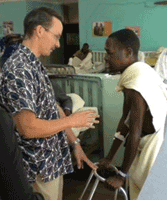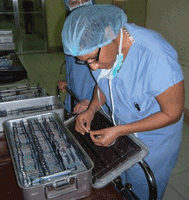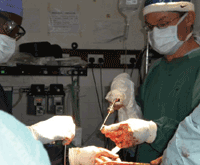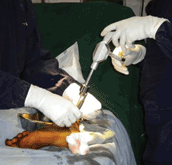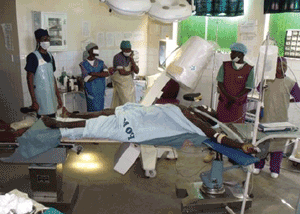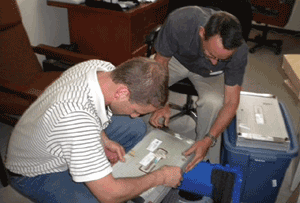Orthopaedic Link seeks to resolve implant supply problems in developing nations
The new organization is also working to form a consortium of philanthropic alliances with the Surgical Implant Generation Network (SIGN) and similar groups.
With an interest in improving health care in developing countries and a background that includes working for Doctors Without Borders as well as the World Health Organization, it is no surprise that orthopedic surgeon Dheera Ananthakrishnan, MD, MSE, is one of the founders and also the president of Orthopaedic Link, a start-up organization that seeks to pair up surplus implant inventory with surgeons and patients in low and middle income countries.
“Our mission is to take this idle surplus inventory that all of these orthopedic implant companies have, assess where it is and what can be used. At the same time, we assess surgeons who are on the ground in the developing world, as well as non-governmental organizations (NGO). Then we basically match the supply with the needs on the ground,” Ananthakrishnan, an assistant professor at Emory University in Atlanta, told Orthopedics Today.
The impetus for Orthopaedic Link began in 2008 after Ananthakrishnan had a random conversation with an executive for a orthopedic implant supplier While describing the lack of supplies she occasionally encountered in Africa while working with Doctors Without Borders, he noted that unused implants warehoused in the United States are often underutilized, idle or worse, discarded.
|
|
Images: Orthopaedic Link |
Founded to solve problems
In thinking about the problem, she then relayed what she had learned to another orthopedic surgeon, Jim Kercher, MD, a resident at Emory at the time. He said that it sounded like a supply chain problem and mentioned that his wife, Heather Kercher, was a supply chain consultant with experience in streamlining the supply chain process. After several brainstorming sessions, the three formed Orthopaedic Link, an organization that is basically designed to serve as a link, or clearing house, between implant companies with idle early-generation or surplus orthopedic implants and appropriate recipient sites in developing countries.
|
|
|
An integral part of this model requires identifying facilities in developing countries with a sufficient infrastructure, including operating rooms, access to anesthesiology and radiography, the ability to conduct follow-up and processes in place for storing and tracking implants — not to mention surgeons with the appropriate skill sets to actually perform the procedures. Ideally, to avoid what Ananthakrishnan described as “reinventing the wheel,” Orthopaedic Link would work in collaboration with philanthropic organizations, such as Orthopaedics Overseas, the Scoliosis Research Society or the Surgical Implant Generation Network (SIGN), that have existing sites and relationships in developing countries.
Medtronic was the first company to step up to the plate and donate surplus implants and instrumentation. Because the list was comprised of spinal instrumentation, the next step was to find a site capable of doing spine surgery.
|
|
Pilot sites
Once again, a random conversation played a role in making Orthopaedic Link become a reality. At a dinner during a SIGN conference, Ananthakrishnan was seated next to Gilbert E. Cauilan, MD, a spine surgeon at Davao Medical Center in the Philippines. They started a conversation that ultimately led to the selection of his center, which is a SIGN site, as Orthopaedic Link’s first pilot site.
In February 2009, the first Orthopaedic Link trip with donated instruments was made to the Philippines. Over $100,000 worth of surplus spine instrumentation donated by Medtronic has been used at Davao Medical Center since that trip, Ananthakrishnan said.
In November 2009, Orthopaedic Link established a second pilot site in Malawi, another SIGN site. General orthopedic trauma surgery was performed with a one-time donation of Synthes implants.
Between the two pilot sites, Ananthakrishnan estimates that more than 100 patients have undergone surgery and received follow-up care they would not have received otherwise. The patients at both sites were charity cases and could never have afforded to pay for their care, she added. In addition, over 20 residents and fellows have been exposed to modern spinal surgery techniques.
Future goals
“Our main goal is to sign on a corporate partner for 2011, keep working with the two sites that we are already working with and not spread ourselves too thin,” Ananthakrishnan said. Currently, Orthopaedic Link is working with Medtronic. In addition, the organization is focusing on establishing an ongoing relationship with Stryker Trauma, as well as other divisions of Stryker.
|
|
Ananthakrishnan also hopes to form bridges with philanthropic organizations. Already working with a small Denver-based organization called the Cornerstone Foundation that makes recurring trips to Cambodia, she would like to see other medical and philanthropic societies, such as the Scoliosis Research Society, become official Orthopaedic Link recipients. She envisions the recipient organizations being able to log onto Orthopaedic Link’s website and pre-order instrumentation, based on previous use. “This would facilitate the process of linking up the organizations with the corporations through Orthopaedic Link — that’s really another big goal,” she said.
Ananthakrishnan acknowledges that expanding Orthopaedic Link will require what she calls change management strategy. “You really have to change the way people look at something, and we’ve realized that even though we want things to happen really quickly, big changes take time,” she said. “Our consolation is that we keep moving forward and we’re helping patients.” – by Mary L. Jerrell
Reference:
- www.orthopaediclink.org
- Dheera Ananthakrishnan, MD, MSE, can be reached at 2221-D Peachtree Road, Suite 396, Atlanta GA 30309; 206-295-1250; e-mail: dheera@orthopaediclink.org.

